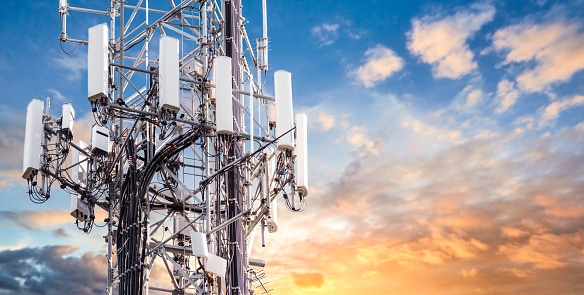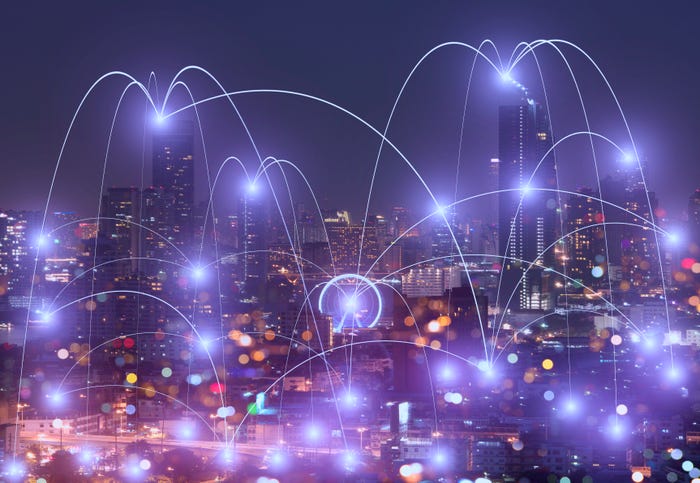It may take a decade for 5G to take hold, but utilities have put hopes in 5G in the energy sector to benefit operations.
February 21, 2020

Cell service companies want you to believe that 5G’s fat, fast pipes are already lighting up broadband communications coast to coast. That might be an overstatement.
The spec sheet for the proposed 5G standard is likely to generate considerable excitement among telecom pros and users alike, so you can’t blame service providers for resorting to a hyperbole in their messaging. But the truth is, a 5G standard has yet to be ratified.
“The 5G standards are still being revised—there isn’t even a final spec on 5G,” said Richelle Elberg, principal research analyst, energy connectivity, at Navigant. “The hype cycle right now is really premature.”
Still there’s plenty of documentation defining how it will work and the kind of performance it’s expected to yield. Those docs and implementations of some features likely to become part of the final standard are enough to get IoT engineers excited, particularly those in the energy sector, although a cautious approach makes sense.
“No utility is going to build a 5G network today, no one,” added Elberg. “They’re going to build a 4G network and then over time they’re going to deploy software upgrades.”
A leap to 5G is unlikely, until utilities gain more experience with 4G technologies.
What 5G Promises
In describing the benefits of 5G, it’s hard to avoid the proverbial tech mantra of “bigger, faster, cheaper.” The anticipated standard will boast a spec sheet that outdoes 4G’s by wide margins.
Speed, reduced latency and the ability to support many devices are 5G’s basic benefits. But that is an understatement when you consider the possibility of theoretical speeds up to 20 Gbps with more practical rates ranging from 5 Gbps to 10 Gbps, which leaves 4G in the dust by a range from 20 to 100 times.
Latency in the 4G world lingers around 50 ms, while 5G should be able to trim that down to as low as 1ms.
The 5G pipe isn’t just fast, it’s also fat, which will allow it to connect thousands to millions of devices depending on configurations and applications. The real-world numbers may not reach into the millions, but they will be a significant increase over 4G— a tangible benefit to utilities managing energy distribution.
“A lot of the goals of the smart grid are to have more real-time interaction between supply and demand,” said Matt Chester, energy analyst at Chester Energy and Policy. “So when you have the ability on the grid to see demand rising instantaneously more or less with 5G. then the utilities are more able to respond to that.“
There will be three versions of the 5G protocols—low-, mid- and high-band 5G—differentiated by a range of operational frequencies. The high-band edition represents much of the “newness” of 5G, as it uses short-range waves which translates into flat-out speed.
The Route to 5G via 4.5G and 4.9G
The 5G protocol is built on the foundation created with the 4G standard, and the progression from 4G to 5G is actually being accomplished with a couple of “standards stops” along the way, notably 4.5G and 4.9G.
Among other enhancements, 4.5G offers higher speeds than 4G, and 4.9G kicks those speeds up while reducing latencies to about 2 ms.
These interim “Gs” have gotten little publicity outside the confines of hard-core broadband networking technologists, but they illustrate that the path from 4G to 5G might not be a terribly disruptive process.
“As the 5G standards are finalized and the 5G industrial ecosystem develops, 5G will be added to existing private 4.9G utility private networks where there are specific applications that require it,” said Kenneth Rabedeau, global energy CTO Nokia, in an email exchange.
For utilities, even 4G networking might represent a new twist in grid development plans. “What you are seeing right now is deployment of private 4G, or discussions about deployment of private 4G networks,” Elberg said, “which has all of the bandwidth and latency capabilities that utilities need for most applications.”
That promise of an easy upgrade to 5G could make 4G an attractive networking alternative. “Ultimately, of course, any utility that deploys 4G gets to 5G,” said Elberg.
Equipment and service suppliers share the opinion that 4G and its variations are likely stepping stones to 5G. Nokia’s Rabedeau wrote that “most private LTE networks built today are 4.9G and will allow coexistence with a 5G network, and the evolution from private 4.9G to 5G with reuse of many of the private 4.9G networks.”
Jay Olearain, director of product and new business innovation for Verizon, said in an email that “existing non-embedded IoT technologies will operate over 5G wireless technologies.” That should allay upgrade concerns for early adopters.
5G’s Prominence in Grid Planning
Utilities might not be ready to go all in on 5G at this point, but it’s a point of discussion as grid architects plot their future networks. Most experts see 5G as a viable alternative in five to 10 years, but considering it now is an essential part of the planning process.
“There’s a lot of talk about this—the smartening up of the grid and how 5G will impact that significantly,” said Chester. “It’s definitely not going to take anyone by surprise—the conversations that need to happen are happening now.”
When utilities, DERs [distributed energy resources] or other energy industry organizations do start to dip their toes in the 5G pond, it will be on a limited, closely monitored basis as there’s simply too much at stake to take chances with energy production or distribution.
“I’m sure it’s going to start in a more of a controlled pilot situation, which a microgrid scenario would be perfect for given that it’s a lot more localized,” said Chester. “You’re on a smaller scale and you can really study the impact.”
Wi-Fi 6: 5G Friend or Foe?
5G isn’t the only new communications protocol that might interest energy IoT developers and maintainers. Wi-Fi 6, the latest iteration in the ubiquitous standard, rolled out late last year by the Wi-Fi Alliance, the industry organization that helps set and certify standards for Wi-Fi communications.
Wi-Fi 6 (802.11ax) will undoubtedly find its way into the infrastructure of many energy grids as its predecessor standards are currently in use in those environments. Like 5G, Wi-Fi 6 increases Wi-Fi speeds, reduces latency and makes it possible to connect more devices. While the Wi-Fi specs don’t really compete at the levels 5G can achieve, it may still be a good fit for energy IoT.
“Technology like Wi-Fi 6 will still have a place, often as a complementary element,” Verizon’s Olearain said.
It won’t be surprising to see organizations tap both techs in their upgraded grids— their basic traits and new features might make them excellent partners.
“5G has new multi-access features to allow for more graceful coexistence and offload capabilities,” said Nokia’s Rabedeau, “plus Wi-Fi 6 has more mature integration and scaling capabilities to allow it to complement 5G.”
Benefits of 5G for Utilities and DERs
However long it takes an energy organization to implement 5G and wherever in its grid infrastructure it employs the technology, the benefits may outweigh potential growing pains.
The speed and volume of data that 5G can support are the key attributes with the greatest impact on energy grid operations. With almost immediate feedback from sensors in the field and equally fast response times, operators will have greater control over the ebb and flow of power along their lines.
With its ability to handle a large number of devices, 5G could also play a key role in the management of renewables while providing a new level of interactive monitoring and preventive maintenance.
It may also enable utilities and other 5G-enabled energy organizations to offer new services above and beyond delivering power to their users. “5G, much like 4G, will enable new applications and services that have not been thought of to date,” Olearain said.
For example, Nokia’s Rabedeau suggested that “they can offer electric vehicle management to consumers and to large locations with fleets or large EV populations.”
Rabedeau also envisioned utilities’ 5G infrastructures as a potential source of new revenue and new customers: “Utilities can also leverage their infrastructure to offer 5G radio connectivity and backhaul services to service providers,” he said.
Elberg concurs. “Utilities have a lot of fiber that carriers might be interested in leasing—they have a whole lot of excess capacity,” she said.
There’s no shortage of promise for 5G today or the amount of attention it’s receiving, but it may take some time—five to 10 years—to see how this story finally unfolds.
About the Author(s)
You May Also Like




.png?width=700&auto=webp&quality=80&disable=upscale)
.png?width=300&auto=webp&quality=80&disable=upscale)


.png?width=300&auto=webp&quality=80&disable=upscale)